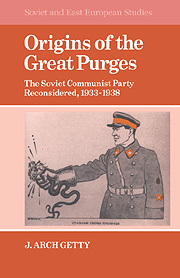Book contents
- Frontmatter
- Contents
- List of tables
- Preface
- Introduction: the Great Purges as history
- 1 The Communist Party in the thirties
- 2 What was a purge?
- 3 The Verification of Party Documents of 1935: a case study in bureaucratic ineptitude
- 4 Radicalism and party revival
- 5 Radicalism and enemies of the people
- 6 The crisis matures: 1937
- 7 Epilogue: the Ezhovshchina
- Conclusion: some observations on politics in the thirties
- Appendix: the Kirov assassination
- Bibliographic essay
- Notes
- Index
- SOVIET AND EAST EUROPEAN STUDIES
5 - Radicalism and enemies of the people
Published online by Cambridge University Press: 23 September 2009
- Frontmatter
- Contents
- List of tables
- Preface
- Introduction: the Great Purges as history
- 1 The Communist Party in the thirties
- 2 What was a purge?
- 3 The Verification of Party Documents of 1935: a case study in bureaucratic ineptitude
- 4 Radicalism and party revival
- 5 Radicalism and enemies of the people
- 6 The crisis matures: 1937
- 7 Epilogue: the Ezhovshchina
- Conclusion: some observations on politics in the thirties
- Appendix: the Kirov assassination
- Bibliographic essay
- Notes
- Index
- SOVIET AND EAST EUROPEAN STUDIES
Summary
Under present conditions, the inalienable quality of every Bolshevik must be the ability to detect the enemy of the party however well he may be masked.
Closed Letter of the Central Committee, July 29, 1936Moderate views on economic planning and the treatment of the opposition had carried the day at the 1934 party congress: A subcommission under Stalin's chairmanship had rejected Molotov's high industrial targets, and Stalin had noted that the opposition had been “smashed” in the party and that “there is no one left to fight.” But mid-1936 would see a resurrection of debate on both these issues as N. I. Ezhov and V. M. Molotov reasserted radical solutions to these controversies. Although this resurgent radical current did not at first threaten the party apparatus, its effects eventually created a climate that did.
The assassination of Kirov in December 1934 had seen a brief flurry of diffuse antiopposition radicalism. The Moscow leadership had been unprepared for the shooting, and, at first, Pravda did not know whom to blame for the killing. Rather than moving forcefully against key leaders of the opposition, the regime lashed out at White Guards, “former people,” and persons already in prison. Such blind rage against traditional class enemies does not suggest a major planned campaign against leading dissidents, and it would be more than a year before the first capital trial of the opposition leadership.
Yet the trial of Zinoviev and Kamenev for moral complicity, combined with certain maneuvers in local party committees, showed that radicals did make a halfhearted and unsuccessful attempt to incite the party against the opposition.
- Type
- Chapter
- Information
- Origins of the Great PurgesThe Soviet Communist Party Reconsidered, 1933–1938, pp. 113 - 136Publisher: Cambridge University PressPrint publication year: 1985



